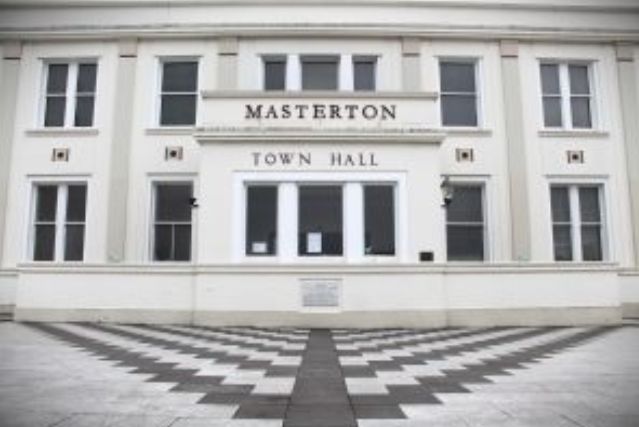
After almost a decade in limbo, Masterton’s town hall and municipal buildings will be wiped from the town’s streetscape.
Independent commissioner Alistair Aburn has granted resource consent for the council to demolish its century-old civic buildings.
It followed several turbulent years of consultation and decision-making marked by controversy, public complaints, and protests.
Masterton Mayor Gary Caffell said he felt a mixture of “relief and trepidation” with the outcome.
“Relief because it could bring to a conclusion a debate which seems like it has gone on forever without any sign of resolution; trepidation because there is always the chance that the decision will be appealed and we will have to go through this latest process all over again.”
He said it had been the most emotionally difficult decision he had experienced in his 15 years on council.
He had previously fought to save the town hall, then he fought to retain the façade, both of which could not be done at a reasonable cost to ratepayers.
“At the end of the day you have to base your decision around what is best for the community both in terms of cost and viability, and I believe we have done that.”
Masterton Ratepayers and Residents Association president Lyn Riley said residents had asked for “vision” from the council but instead “got a bulldozer”.
“Demolishing our iconic town hall ignores heartfelt community concern, lacks a business case, and leaves ratepayers with more long-term debt when they are facing costly water reforms.
“No modern structure or architectural drawing can replicate their historical value or the deep connection to those who came before us.
“This is not progress – it’s erasure.”
How we got here
In 2016, the town hall was closed after it was found to be earthquake-prone.
In 2019, Masterton District Council consulted on building a new civic facility and this direction was agreed upon the next year.
As part of its 2021-31 Long-Term Plan process, the council locked in a budget of $26.8 million it would borrow to build the new civic facility, and $4 million from external sources.
A site at the northern end of Masterton had been earmarked for this new build.
On the day the 2021-31 Long-Term Plan was adopted, an estimated 1000 people gathered at the town hall site for the “Hands Around the Hall” protest.

Attendees wanted the town hall to be strengthened or rebuilt on the same site and the façade retained.
Former council chief executive Kath Ross had been caught on CCTV ripping down a poster promoting the event and later resigned.
Residents protested again in 2022, this time at the recreation centre site that had been earmarked for a potential build.
That same year, the Auditor-General found there were flaws in the council’s record keeping over the civic facility location decision and looked into whether councillors had dealt with conflicts of interest appropriately.
The Ombudsman was also involved in determining whether consultation on the project had been rigorous enough and found in favour of the council.
Later that year, the project was placed on hold after estimates put the cost of the new civic facility at more than $70 million, inclusive of contingency.
A new council was elected later that year and in 2024, this council voted to demolish the town hall and municipal building and build anew on the same site for a cost of no more than $25 million.
A resource consent application to demolish the buildings was lodged at the end of the year and a hearing was held in April.

What the commissioner said
In his decision, released on Monday, Commissioner Alistair Aburn said the demolition of the buildings was “an appropriate use of physical resources”.
He said the council had undertaken “a sufficiently robust assessment of alternative options” which could not be pursued.
He also said the retention of the façade was unlikely to be financially viable.
“The demolition of the town hall, a scheduled heritage building, will have more than minor heritage effects,” Aburn said.
“However, when regard is had to the other matters requiring assessment ... including the positive effects of removing an earthquake-prone building thereby enhancing public safety and enabling the future construction of a fit for purpose town hall built to 100% of the new building standard (NBS), I consider loss of historic heritage values has been offset to an acceptable degree.”
At the hearing, Aburn expressed concern that the site would be left vacant after the demolition and had set conditions to mitigate this risk.
He said a “public space activation plan” prepared by a suitably qualified landscape architect or designer would need to be approved before demolition works began.
The plan would need to include the design of an interim landscaped open space that activated the site, maintained visual amenity, and encouraged safe public use once demolished.
The council would need to provide an indicative timeline or project plan for the design of the replacement building, as well as draft concept plans before demolition.
Another condition of the consent was the preparation of a full inventory of materials that may be salvaged for reuse or sale and that there be an installation of interpretative material and memorabilia in the replacement building, which would allow the public to engage with the history of the site and the buildings which originally existed there.
The council would also need to obtain an archaeological authority from Heritage New Zealand Pouhere Taonga under the Heritage New Zealand Pouhere Taonga Act 2014 prior to any demolition works commencing.
The resource consent would be valid for five years from the date it was granted.
Next steps
Caffell said the council had decided that a new build be pursued once the site was demolished.
The budget for the demolition and build had been set at $25 million.
“No one can deny that will be a challenge,” he said.
“I am encouraged though by the fact that there are developers and people within the construction industry who believe it can de done and we will obviously be leaning on their expertise along the way.”
A fundraising group led by former Masterton Mayor Bob Francis had been established and had some “innovative plans”, Caffell said.
“It is probably worth noting too that while council is not now supporting the retention of the façade, there remains the possibility that some parts of it could still be incorporated in any new design.
“That is still very much in the exploration stage but personally I get quite excited about what we might be able to achieve there.”
He said the “cheeky” side of him saw value in approaching neighbouring councils for financial support for the facility as it was likely to hold a crowd “twice as big as any currently available in the Wairarapa”.
“This will mean that some of the bigger shows which have to give this region a a miss because of their size will have the opportunity to come to Masterton, and the entire region will benefit as a result.”
Now that a decision on the demolition consent has been made, appeals can be lodged to the Environment Court within 15 working days of May 26.
Council infrastructure and assets manager Maseina Koneferenisi said the council was pleased with the outcome and would start to engage with relevant experts to work through condition requirements.
LDR is local body journalism co-funded by RNZ and NZ On Air



 Gordon Campbell: On The Costs Of Regulating Cost, And Burkina Faso As A Role Model
Gordon Campbell: On The Costs Of Regulating Cost, And Burkina Faso As A Role Model Dog Lovers of Monte Cecilia: Locals Challenge Puketāpapa Local Board And Auckland Council’s On-Leash Policy Change For Monte Cecilia Park
Dog Lovers of Monte Cecilia: Locals Challenge Puketāpapa Local Board And Auckland Council’s On-Leash Policy Change For Monte Cecilia Park Maritime New Zealand: Three Rescued In High-Seas Operation After Vessel Abandoned North Of New Zealand
Maritime New Zealand: Three Rescued In High-Seas Operation After Vessel Abandoned North Of New Zealand Health Coalition Aotearoa: Experts Urge Fix As Government Expands Failing Lunch Scheme To Primary Schools
Health Coalition Aotearoa: Experts Urge Fix As Government Expands Failing Lunch Scheme To Primary Schools Helen Clark Foundation: The Helen Clark Foundation Launches Honorary Fellow Programme
Helen Clark Foundation: The Helen Clark Foundation Launches Honorary Fellow Programme Department of Conservation: Call For Public Information On Auckland Marine Mammal Cases
Department of Conservation: Call For Public Information On Auckland Marine Mammal Cases New Zealand Jewish Council: NZ Jewish Council Clarifies Position - Advocating For Safety And Accountability, Not Censorship
New Zealand Jewish Council: NZ Jewish Council Clarifies Position - Advocating For Safety And Accountability, Not Censorship


